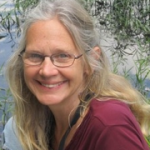By Leslie Bishop, Ph.D.
My name is Dr. Leslie Bishop and I am a retired Professor of Biology at Earlham College. I live in Brown County and my property is on the border of Yellowwood State Forest. The Old Forest Bill (Senate Bill 420) will ensure that 10% of Indiana’s state forests can mature into old forests. Old forests are rare in Indiana. Old-growth forests provide habitat that supports rare biological diversity and unique assemblages of animals, plants, and fungi that are found nowhere else but in old-growth forests.
Large unlogged areas of interior forests provide lifeboats for mobile species affected by logging practices. Older growth forests provide snags and large standing dead trees that provide habitat for many mammals, birds, and insects. When big old trees die, they leave soil pits and tip-up mounds, as well as rotting logs, which create unique habitats for many species including amphibians, mammals, spiders, and insects. The large gap that results when an old tree falls, allows for sunlight to reach the forest floor and create conditions suitable for seeds to sprout and early successional plants to thrive.
Our knowledge of biological diversity is in its infancy for our Indiana forests. We know a lot about vertebrate diversity. In fact, more than 120 species of mammals, birds, reptiles, and amphibians require our forests for feeding and successful reproduction. However, we know very little about the other 90% of all animal species such as insects, spiders, millipedes, and snails. All of these species play important roles in the ecosystem through food webs, decomposition, and healthy soil development. Last year the spider team, which I participated in at the Morgan-Monroe/ Yellowwood State Forest Ecoblitz sponsored by the Indiana Forest Alliance, discovered a new species. The spider team discovered an undescribed species, never found before that is brand new to Science. We were so excited. Can you imagine, as biologists, finding a new species right here in Indiana? We usually think of this happening in a rainforest. But, it happened right here in Indiana.
In addition, in a recently published paper, we used data from multiple surveys and recorded on 72 spider species that had never before been reported in Indiana. Forty percent of those species were collected in Morgan-Monroe State Forest and rely on forest habitat. How many more will we discover if we continually survey these areas?
A hands-off approach on 10% of forests will enable the development of this forest type and site conditions that were historically common, but now are rare in Indiana. Mature forest plots will provide opportunities for scientific study of natural processes of aging forests, including natural disturbances, biogeochemical cycles, soil development, and specific relationship with species. In addition, they provide critical experimental control for assessing the consequences of active management that occurs in the larger areas of the managed forest.
In conclusion, old-growth forests that are older than 140 years are rare in Indiana. By preserving 10% (Senate Bill 420) of each state forest from logging, we are ensuring the future of this biologically rich habitat. Please support this bill.
The preceding testimony was presented by Dr. Leslie Bishop to the Indiana Senate Natural Resources Committee on Monday, February 13, 2017 during the hearing for Senate Bill 420. View the video of Dr. Bishop’s testimony. View the handout, including citations, of Dr. Bishop’s testimony.
Dr. Leslie Bishop is a retired professor of biology from Earlham College in Indiana where she taught for over twenty years. Her courses included Invertebrate Zoology, Insect Biology, and Biological Diversity. In addition, she enjoyed teaching her tropical field courses: Marine Biology in the Bahamas and St. John, USVI, and Tropical Ecology in Costa Rica and Galapagos. She included many undergraduates in her research both in Puerto Rico and Dominica. Since retirement, she has been fortunate to have new opportunities. Among them teaching Wildlife Ecology in Tanzania and teaching as a Fulbright Scholar in Dominica. Her current interest is to raise awareness about the conservation of biodiversity and to encourage people to learn about the natural world.
Please contact your state senator and ask them to support Senate Bill 420.

